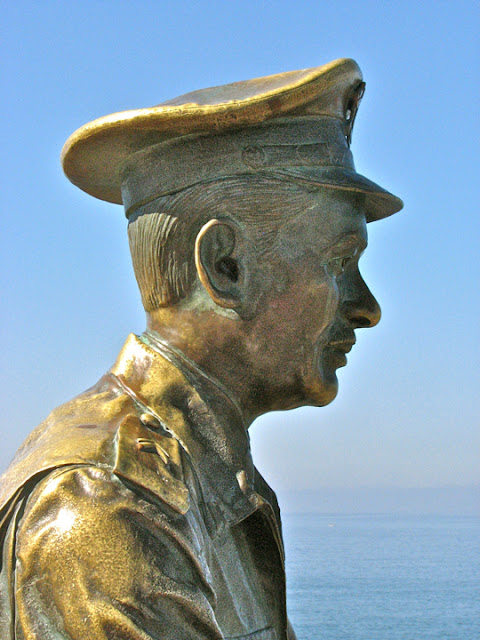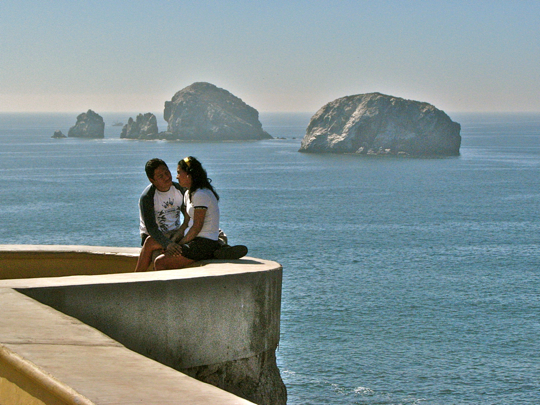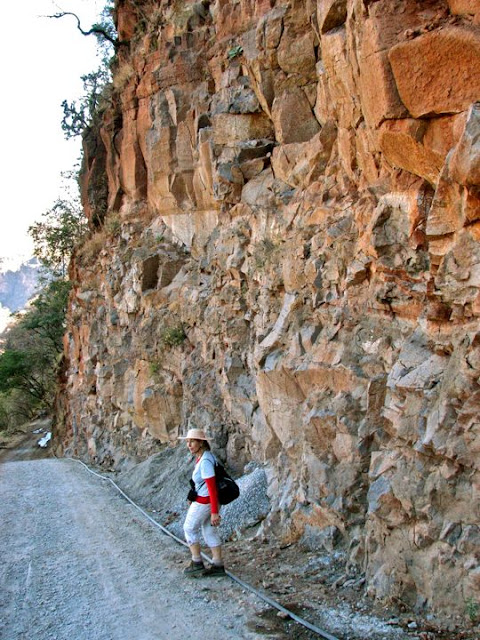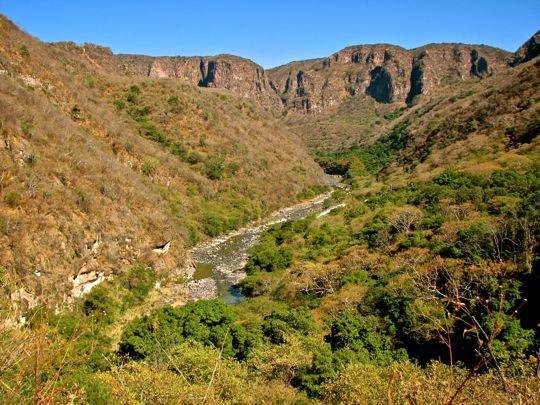Two steep hills bracket Olas Altas beach. This photo was taken from Cerro de la Neveria (Icebox Hill), looking south toward Cerro del Vigia (Watchtower Hill). Beyond Cerro del Vigia is the conical peak known as El Faro. A lighthouse perches on top of El Faro to guide ships and fishing boats into the inner harbor. Playa Olas Altas is the beach closest to El Centro, the wonderful "old town" section. El Centro occupies most of a thumb-like peninsula at the south end of Mazatlán bounded by the Pacific Ocean on the west, the ship channel on the south, and the inner harbor estuary on the east. The tip of the thumb is comprised of Cerro del Vigia and El Faro, connected to each other by a narrow causeway. For a map showing all these areas in relation to one another, click here. For a Google map showing Mazatlán in relation to the rest of Mexico, click here.
The Mazatlán Malecon stretches north, all the way from Olas Altas to the Zona Dorada. A malecon is a beachfront walkway. This one is wide, decorated with wonderful sculptures, and lined with cliffs, rocky points and golden beaches. It is also amazingly long, stretching northward 11.2K (7 mi.) from Cerro Vigia to the Zona Dorada (Golden Zone). The view above is from our hotel balcony, north toward Cerro de la Neveria, from which I took the previous photo. The two hills at either end of Playa Olas Altas are quite steep, with sheer cliffs extending down to the rocky shore. They give Olas Altas a cozy, secluded feeling, separating it a bit from the glitzy hustle and bustle of the beaches to the north. Icebox Hill got its name from caves where 19th Century Mazatlecos stored ice for refrigeration. Since those days, Cerro de la Neveria has acquired several tiers of large, expensive homes perched on the cliff tops.
One of many modes of transportation along the malecon. A young girl, bathed in the rosy glow of sunset, skates to the tune on her ipod. At almost any time from dawn to well after dark, the malecon teems with skaters, skate-boarders, bicyclists, joggers, or those just out for a stroll. In many places, the architects used natural outcrops to design nooks and lookout points so that visitors could enjoy the spectacular scenery, and lovers snuggle as they watch the sunsets.
Our hotel, La Siesta, faces the ocean across the malecon and Playa Olas Altas. La Siesta is an old hotel, popular with US movie stars like John Wayne and Tyrone Power in the 1950s-60s. It fell on hard times after the Golden Zone hotel district was developed to the north. In recent years, it was upgraded and some work is still continuing. While not fancy, La Siesta possesses all the normal attributes of a hotel, and everything worked properly while we were there. The room price ($48/night) was modest for January in Mazatlán. In addition to a stunning ocean view, the hotel has a travel agency on the first floor, and the Shrimp Bucket restaurant occupies the north end. The Shrimp Bucket is an old and very popular local seafood restaurant and serves excellent food at reasonable prices.
A room with a view. La Siesta provided Carole with an ocean view room for only the second time in her life, and she was very excited by the prospect. Above, you can see our balcony on the 3rd floor directly over the main entrance. The guest with arms extended was apparently embracing the prospect of everlasting glory, enshrinement in my blog. Seconds after I snapped the photo, he mounted his motorcycle and was gone. From our balcony, we could enjoy the gorgeous, golden sunsets, and later drift off to sleep listening to the rhythmic roar of the breakers below.
Alfredo, and his trusty pulmonia. These odd little vehicles, distant relatives to golf carts, provide much of the transportation in Mazatlán. The pulmonias wear a VW emblem, and the engine sounds like my old bug, but the body is unique to Mazatlán. They are inexpensive, somewhere in price between a bus and a taxi. They are also a bit airy, so I advise a jacket or sweater if the day is cool. Alfredo was a lively young guy who took us on a tour of El Centro and up to the Golden Zone. He spoke a smattering of English and, along with our slowly improving Spanish, we communicated just fine. He was very understanding about my frequent appeals for photo stops. You can hardly walk a dozen steps anywhere in El Centro or along the malecon without one of these pulmonias veering over so the driver can ask if you want a ride. One tip: make sure you negotiate a price before you get on board. If you don't like the price, there'll be another pulmonia along in a couple of minutes--or sooner!
La Mujer Mazatleca was created for the women of Mazatlán. The bronze statue was smelted in Mexico City to celebrate the women of Mazaltlán, locally reputed to be the most beautiful in the world (a designation I suspect may be claimed by a few other places). Gabriel Ruis, a composer from Jalisco, unveiled it. He is famous for writing a number of songs celebrating this coastal city, including "Mazatlán", "Nights of Mazatlán", and "Secret from Mazatlán." Although this photo was taken mid-day, the fog we encountered nearly every morning created a misty background to the statue.
Beautiful to view, but perilous for sailors. Below steep cliffs, rocky outcrops thrust into a roiling, foaming sea. It is the nightmare of sailors to encounter something like this on a dark, foggy night.
Pedro Infante, Mexican singer and movie star, was born in Mazatlán. Pedro Infante is somewhat of a cross between Elvis Presley and James Dean in Mexican culture. Born in Mazatlán in 1917, he studied music and became proficient in a variety of instruments as well as with vocals. He cut his first record in 1943, the same year that he appeared as an extra in his first film. Infante became a wildly popular star in both arenas, recording 350 songs and acting in 60 movies before his death in 1957. The statue above is one of four commemorating Pedro Infante. The motorcycle in the statue references his role in the movie "A Toda Máquina" (All Machine).
Infante died tragically at the height of his fame and popularity, not unlike Elvis and Dean. He was a private pilot and crashed on April 15, 1957, near Mérida, while flying a converted WWII B-24 bomber on a trip from the Yucatan to Mexico City. Among Mexico's new urban working class of the 1940s, Infante was a hero for his portrayals of a working class man in a trilogy of films called "We the Poor," "You the Rich," and "Pepe the Bull." He also played many roles as a charro, the idealized cowboy of rural Mexico, popular both with the rural poor and the recently-rural urban workers. Like the actor James Dean, he died tragically in an accident. Like singer/actor Elvis Presley, a cult developed that asserted he was not dead but alive and in hiding. I was particularly interested in his statue. Notice how every line and crease of his clothing, body and even of the mototcycle is shown. It is almost as if the sculptor dipped Infante in bronze while astride his bike, as people used to do with baby shoes.
One of many homes perched atop a rocky cliff, facing the open ocean. When a storm hits the coast here, living in this house must be pretty dramatic with huge waves smashing against the cliffs below. Notice the three islands in the distance. From left to right they are Isla de Chivos (Goats), Isla de Venados (Deer), and Isla de Pájaros (Birds). Tour boats stop by Isla de Venados, the largest of the three. I'm not sure there are deer on the island, but the snorkling and diving is reported to be excellent.
Lovers chat on an nook high above the crashing breakers. The several large rocks just off the coast near Cerro Vigia are called Piedras Blancas (White Rocks). The white color comes in part from the rocks themselves, but also from the guano of innumerable birds of the various species that nest there. One of the smaller rocks is a favorite gathering place for sea lions, also a popular stop for the tour boats.
Playa Norte curves from Cerro de la Neveria around the bay to the Zona Dorada. The photo was taken from the top of Cerro de la Neveria looking north. This is probably the longest unbroken stretch of beach in central Mazatlán. The Zona Dorada, or Golden Zone, is at the far left of the beach seen above.
And what would a beach be without pretty girls...? These three Mexican girls were shopping for a secluded stretch of beach. They gave me their best coquettish smiles when they noticed my camera.
Playa Tiburón comprises the first stretch of the much larger Playa Norte. Tiburón is Spanish for shark. The name is appropriate because this is the beach where the local fishermen pull up their boats to clean their catch, and to patch and repair their boats and nets.
A fisherman cleans his catch under the watchful eye of a would-be assistant. When I snapped this shot, I didn't even notice the pelican at first. I am always amused by the friendly relationship between these two species who both depend upon fishing for their livelihood. The pelicans are not the least bit shy as they intently wait for any tidbit offered by the fisherman, or perhaps any he has neglected to safeguard.
Another of the malecon's unusual statues. I have never before seen a statue dedicated to a mode of transportation. Even Pedro Infante's statue was about him rather than his motorcycle. However, pulmonias are such a fixture of Mazatlán life that I suppose it is appropriate that they be memorialized. Like Infante and his motorcycle, every detail of the pulmonia is included. The fog was really rolling in at this point, hence the almost white background.
Xanadu on the beach. This was the beginning of the Golden Zone. Playa Norte ends here, along with the malecon. The structure on the point of land looked at first like some fantastic version of a Mormon Temple, but it turned out to be a combination restaurant and disco-bar. I nick-named it after Samuel Coleridge's poem which begins "In Xanadu did Kubla Khan a stately pleasure-dome decree..."
The view down Playa Norte from the Zona Dorada, looking south. Having previously shown quite a few cliffs and rocky shores, I didn't want to leave the wrong impression of Mazatlán. There is, indeed, a bit of beach here. Cerro Neveria can be seen at the upper right.
A show to remember. Alfredo, our pulmonia driver, dropped us off at this point near the bottom of the Cerro Neveria cliffs so that we could enjoy the stroll back to our hotel. I was a bit puzzled at why someone would build such a platform on the top of this natural rock tower. As people gathered along the malecon, I realized something was about to happen.
Diver at the "moment of truth." Some young men climbed the steps of the tower, skins glistening as seawater streamed from their bodies. "Oh my god," I said to my self, "they're actually going to dive into that narrow slot of water!" The drop is at least 12.2 meters (40 ft). Even as I said it, the diver above leaned forward into his launch. He would have to dive pretty far out to miss the jagged rocks immediately below. Who knew what might lie just under the surface of the foaming seawater below?
No turning back. The young diver gracefully floated down and cut cleanly into the sea. After a moment, he emerged and began his long climb back to the top of the tower. We were well on our way back to the hotel before we realized that we should have stuck around to offer a tip for his performance. We'll tip the divers nicely when we return to this spot. The show was pretty spectacular and definitely worth seeing.
A man and his small son enjoy the late afternoon sun along Playa Olas Altas. The afternoon was all golden light and sparkling sea as we watched from our balcony. There was always something to catch our eyes as we leaned back in our chairs in comfortable tiredness.
A Mazatlán sunset, one of many we would see on this adventure. As the sun approaches the horizon, fishing boats head back to Playa Tiburón for the night. Every sunset on our trip was a little different, but every one was spectacular in its own right.
This concludes Part 1 of my multi-part series on Mazatlán. In Part 2, I will show you what we found as we strolled around El Centro and its Plaza Machado. I always appreciate feedback. If you'd like to leave a comment, you can do so either in the Comments section below, or by emailing me directly. If you leave a question in the Comments section, PLEASE leave your email so that I may respond.
Hasta luego, Jim


































































